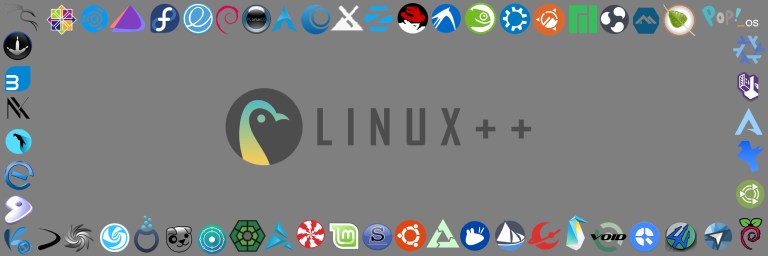
Hello and welcome to the seventeenth edition of Linux++, a weekly dive into the major topics, events, and headlines throughout the Linux world. This issue covers the week starting Monday, May 11, 2020 and ending Sunday, May 17, 2020.
This is not meant to be a deep dive into the different topics, but more like a curated selection of what I find most interesting each week with links provided to delve into the material as much as your heart desires.
If you missed the last report, Issue 16 from May 10, 2020, you can find it here. You can also find all of the issues posted on the official Linux++ Twitter account here or follow the Linux++ publication on the Destination Linux Network’s Front Page Linux platform here.
In addition, there is a Telegram group dedicated to the readers and anyone else interested in discussion about the newest updates in the GNU/Linux world available to join here.
For those that would like to get in contact with me regarding news, interview opportunities, or just to say hello, you can send an email to linuxplusplus@protonmail.com. I would definitely love to chat!
There is a lot to cover so let’s dive right in!
Personal News
If you don’t care what I’ve been up to over the past week, feel free to skip ahead to the Community News section 🙂
Playing Around with Ubuntu Unity Remix

If you’ve been following along with Linux++ for quite a while then you will know that I am an unabashed fan of the old Unity7 shell of which I spent nearly seven years of my life using until the announcement of the project’s demise. Since April 2018, I have traveled through the greater Linux world without a singular home, but instead through many different distributions and desktop environments. However, until recently, I haven’t been able to find one that feels quite like home the way Ubuntu and Unity did.
So, obviously, when a new Ubuntu Unity Remix project was announced recently, I knew that I had to take a look and dive deeper. Yes, for the most part, Unity has been in the rear-view mirror since switching to GNOME 3 full-time in February, but its things like these that keep me wondering if I should take a peek at that mirror, if just for a little bit longer.
Though my expectations were not super high considering that the project is still in a very early and amorphous alpha-state, I have to say that I was pleasantly surprised when installing the first ISO on hardware. Besides a few things missing, which has been rectified with more recent ISO images, I was more than happy with the state of the project upon first boot. Yes, this was the old Unity I used to know and love, but somehow it felt fresher. As I worked to regain muscle memory over the key-bindings (GNOME really can take over the way you control your system XD), the experience was smooth, graceful, and fun in a way that is unique to the Unity experience.
During the testing, I did not encounter a single issue that I would deem detrimental or even annoying. Everything from the Dash to the file manager and theming appeared to be just where it had left off, not skipping a beat.
Congratulations to Rudra Saraswat on bringing Ubuntu Unity back to life. I will definitely be interested to see where this project heads and will be sure to keep everyone updated as news drops.
If you’re interested to see Unity on the latest Ubuntu 20.04 base, I highly encourage you to check out the Ubuntu Unity Remix. The latest development ISO image can be found here. In addition, you can follow along with the Ubuntu Unity Remix on Twitter and Telegram.
Also, Jason Evangelho of Forbes, Destination Linux Network, and Linux For Everyone has released a video that takes a look at the distribution and the creator behind it that can be found linked below:
In addition, Rudra is looking for community feedback on the official logo of the Ubuntu Unity Remix. You can find the poll on Twitter here. The two options are presented below:


Community News
Linux Mint 20 “Ulyana” Plans

With the release of Ubuntu 20.04 LTS, it was only a matter of time before the announcements of updates started rolling in from distributions downstream from the LTS cycle. Linux Mint is arguably the most popular of those downstream distributions and, this week, they announced their plans for the next iteration — Linux Mint 20.0 “Ulyana”. Currently, the massive refresh is planned to be available sometime in June this year.
Though there will likely be more information to come out as we get closer to the release date, the Mint developers have given a decent preview of what to expect via their Monthly News Blog for April 2020.
As per usual, Linux Mint 20 will be shipping with the three desktop environments: Cinnamon, MATE, and Xfce. However, support for 32-bit software will be completely dropped from version 20. As aforementioned, “Ulyana” will be utilize the latest Ubuntu 20.04 LTS base, allowing for a much more up-to-date Linux kernel version 5.4 LTS. In addition, home directory encryption will still be supported even though it was discontinued in “Focal Fossa”.

Of course, the flagship edition will ship with the most recent stable version 4.6 of Cinnamon at the time of release and will provide a handful of improvements including a drastic increase in Nemo (Cinnamon’s default file manager) performance, and an increased ability to change the monitor refresh rate with built-in support for fractional scaling on 4K and HiDPI displays. In addition, the systray applet will provide increased support for application indicators and StatusNotifier icons to the Xapp Statusicon applet.
One major new application that the Mint team has been discussing quite a bit this year is that of their new file transfer tool, Warpinator. Yes, they had said earlier on that they were looking for a more professional name for the application, however, as time moved on, the Mint developers became used to and semi-attached to the name and it seems the Mint community has given their blessing on it as well. For fun, some of the alternative names included “Ethernator”, “Datanator”, “XFiles”, “Overcast”, “Capsule”, and “DropZone”.
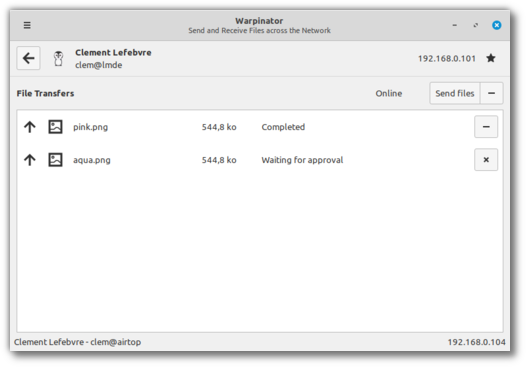
An additional, and awesome, new feature has been added to Warpinator as well — encrypted communication on the network (along with a slick new icon). If you would like to read about all the other features planned for Warpinator, check out the March 8, 2020 edition of Linux++ here.
Other improvements planned to ship with Linux Mint 20 include changing the Apturl backend to aptdaemon in place of Synaptic, a newly refreshed user interface for Gdebi, brighter and bolder colors for the Mint-Y theme (as well as the addition of a yellow folder set), and the ability to easily choose the theme colors from the Welcome application at first boot.
I have to say, Linux Mint has been one of the most solid distributions on the planet for quite a long time now. It still remains the first distribution that I personally suggest to new users (especially those coming from the Windows ecosystem), and the Mint team has done an immensely extraordinary job at making the Linux desktop more accessible than ever. I can’t wait to give Linux Mint 20 a shot when it is released next month and wish all the success in the world to the Mint developer team and greater Mint community!
If you would like to read the official Linux Mint April 2020 announcement, you can find it here. If you would like to try out Linux Mint to see if it might be the right fit for you, you can find the most recent stable ISO image (Linux Mint 19.3) here. Also, if you would like to try out the Linux Mint Debian Edition (based on Debian stable instead of Ubuntu LTS), you can find the download link to LMDE version 4 here.
Ubuntu 20.04 Certified for Raspberry Pie

Without a doubt, the Raspberry Pi line of Single-Board Computers (SBCs) are the most popular devices of their kind in the world. Their proliferation in the technology industry has created such a stir that the ARM processors they utilize are becoming increasingly common on a wide range of electronic devices throughout the world. In addition, the portability and flexibility that these SBCs allow for is unmatched and has given rise to countless possibilities and use cases.
Due to the flexibility of the Linux kernel, the Raspberry Pi devices have introduced Linux to an entirely new generation since it is the primary operating system in use on the devices. So, with the release of Canonical’s Ubuntu 20.04 LTS, the most popular Linux-based operating system in existance, I was happy to hear that the newest edition has become certified for use on the Raspberry Pi.

So, what exactly does this whole certification process entail? Well, I’m glad you asked! Apparently, Canonical’s team behind Ubuntu only certifies hardware that they have spent performing thousands of tests to ensure that the operating system will work perfectly out-of-the-box on those devices, including the Raspberry Pi. In addition, this means that the Ubuntu security team will push security patches every three weeks, so that you can use your Pi with peace of mind. Of course, if critical vulernabilities or exploits are discovered, the Ubuntu security team promises to have those patches out the day of discovery.
Moreover, Canonical has one of the most proven track records in the entire Linux and open source ecosystem. In order to guaruntee that the patches they put out to their Pi users are up to their extremely high standards, they personally test each update on every Raspberry Pi that resides in Canonical’s labs. This will allow users to not worry as much about having any updates that will potentially break their device. And if that wasn’t enough, the engineers at Canonical perform continuous regression testing on each Raspberry Pi they have their hands on throughout the entire lifecycle of an Ubuntu release.
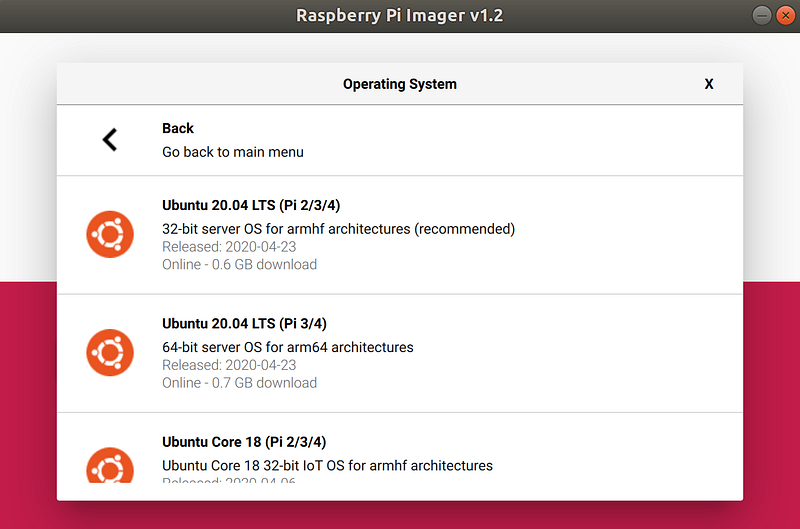
Basically, hardware can only earn the official “Ubuntu Certified” recognition if “Canonical is sure it will deliver the most optimal user experience.” The design and deliverance of certifications like this one are becoming increasingly important in the age of Internet-connected devices due to the inevitably growing cyber attack surface being provided to the malicious hackers of the world.
This is absolutely awesome news coming out of Canonical. Ubuntu is the most widely used Linux system in the world — from the desktop to the cloud and beyond — and having it available for popular, inexpensive, and limitless devices like the Raspberry Pi will help to familiarize an extrodinary amount of new, young (and even the hardened veterans) tech enthusiasts around the world to the power, flexibility, and usability of Linux, just as the Ubuntu desktop did when it took the desktop Linux world by storm with its inaugural release in 2004.
Congrats to the Ubuntu team for making the massive 20.04 LTS release just that much cooler with this announcement!
If you would like to check out the official statement from Canonical’s Rhys Davies, you can find it here. If you would like to try out Ubuntu 20.04 LTS on your model of Raspberry Pi, the installation images can be found here.
Kali Linux 2020.2 Released with a Ton of Improvements!

Kali Linux has long been the premier penetration testing distribution utilized by cybersecurity professionals around the world since its earliest days as BackTrack. Kali was designed by the merger of two competing Linux-based distributions that were focused heavily on penetration testing — WHAX (Slackware-based) and Auditor Security Collection (Knoppix-based).
In the beginning, BackTrack was based off of a popular Linux distribution of the time, Knoppix. Knoppix was unique in the fact that it was specially designed to be run directly from a CD, DVD, or USB flash drive (sound familiar?). When the BackTrack developers at Offensive Security chose to change their distribution to be purely based off of the massively popular Debian distribution in 2012, they also changed the name of their distribution to Kali Linux, reflecting a new path forward.

Today, Kali Linux has grown into the most polished, flexible, and comprehensive penetration testing operating system in the world. In fact, many Cybersecurity engineers take online courses from Offensive Security to become certified in penetration testing with Kali Linux to earn the OSCP, which is a difficult to complete and highly-regarded certification in the field.
This week, Offensive Security announced the availability of the most recent update to Kali Linux, version 2020.2 along with quite a few other intriguing developments. This year has brought some massive changes to Kali and it looks like Offensive Security isn’t planning to take their foot off of the brake anytime soon. In fact, if you haven’t paid close attention to the Kali world for a while, you might want to take a peek at some of the major revisions resulting from the Kali Linux 2020.1 release, which can be found in the February 2, 2020 edition of Linux++ here.
This is going to be a long one, so hold on to your butts! (Yes, Jurassic Park was my favorite childhood movie ;))
First and foremost is the introduction of another desktop environment, to the official Kali themed group (which includes Xfce and GNOME 3)— KDE Plasma. The new Plasma theming is absolutely gorgeous, just as one would come to expect with a distribution as polished as Kali.

While we’re on the topic of makeovers, it appears that the lightdm login screen that ships with Kali has seen a few graphical tweaks itself that makes it look more consistent with the theme as well as an improved layout for the login boxes.
Another major change is that of the inclusion of Window’s PowerShell for Linux by default, well, kind of. Previously, PowerShell was only available through downloading from the Kali Linux network repository manually. Now, the developers have included PowerShell into one of their popular metapackages — kali-linux-large. This means that if you choose to install this package during installation or once Kali is already installed, your computer will automatically have PowerShell if it is compatible with your architecture.
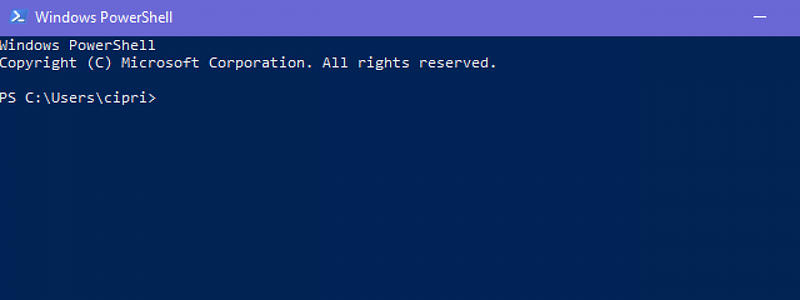
However, the Kali developers do note that PowerShell is not included in their default metapackage, kali-linux-default. The difference being that the large metapackage includes everything in the default package along with quite a few extras. So, for those who are trying to steer clear of a Microsoft stain, make sure to check out what you’re putting on your system ;).
Another area in which Kali has seen improvements is on the increasingly important ARM architecture. The ARM images for Kali have been updated to use the new kali/kali user in place of root/toor as reflected in the 2020.1 desktop release. This means that the root user is no longer the default user on your Kali system. In addition, there are new requirements to run Kali from an SD card on your arm device. The new requirements have upgraded the space needed from 8GB to 16GB or larger in order to run the distribution properly.
In addition, the locales-all package is no longer coming pre-installed on the Kali ARM images so the Kali developers highly recommend that you set your locale by using the following command in a terminal:
~$ sudo dpkg-reconfigure locales
Once you have done that, your device should update by logging out and logging back in.
In addition to all of this, the Kali team has upgraded quite a few packages in their repositories including GNOME 3.36, Joplin (which will replace CherryTree in version 2020.3), Nextnet, Python 3.8, and SpiderFoot.
Also, it is noted that the Kali maintainers are forced to keep a version of Python 2 around for the tools and packages that still require it. They ask the developers behind these specific tools to please upgrade to Python 3 as soon as possible.
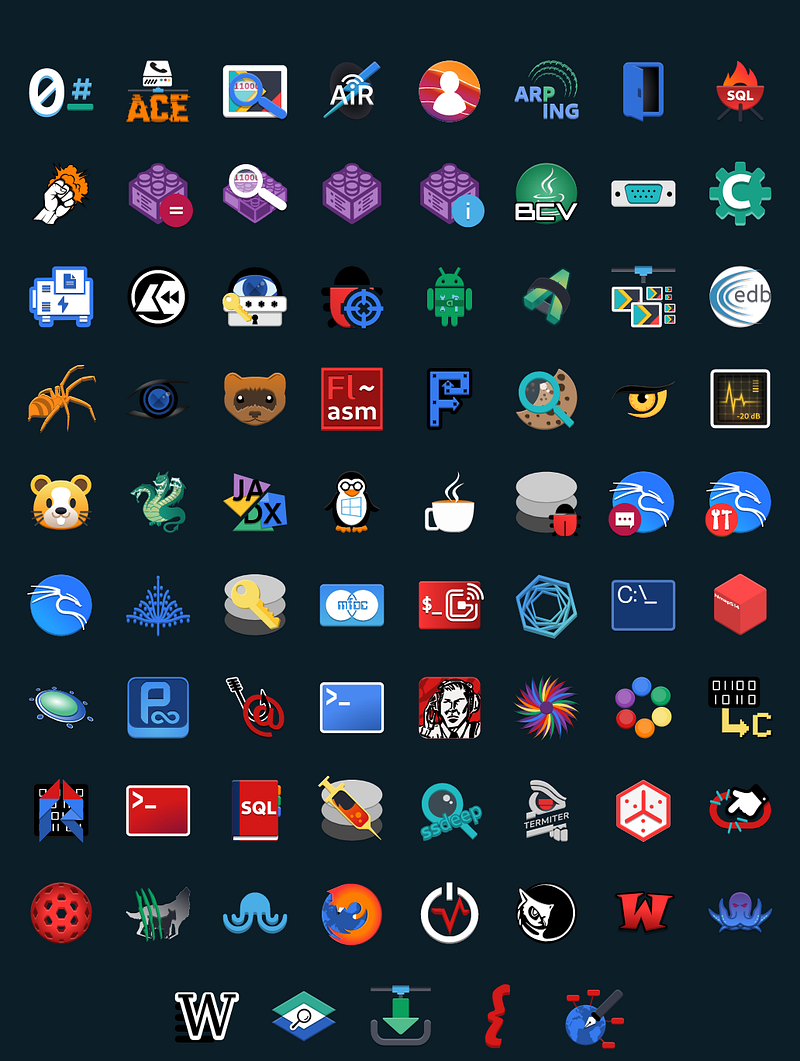
And lastly, the Kali developers have been busy updating the icons for their expansive range of applications which should be extremely apparent in your menu or launcher of choice.
Whew, that was a lot! Of course, I want to congratulate Offensive Security and the Kali Linux developers on once again throwing out an incredible release and continuing to update the polish and look of the distribution. It is just absolutely amazing the amount of work they are able to do between updates and I wish them the best!
There is a ton of more information regarding news about WSLconf, infrastructure improvements, NetHunter, and upgrade info that can be found in the official release notes for Kali 2020.2 here. In addition, if you would like to try out Kali Linux for yourself, all of the available installation images can be found here.
UBports’ Ubuntu Touch OTA-12

UBports has done some incredible work with mobile Ubuntu since Canonical dropped the gig in 2017. However, in the three years since taking over the Ubuntu Touch project, there might be no bigger milestone reached than this week’s OTA-12 release. This is not only an update of the mobile phone system, but an integration of some of the final changes to the desktop UI and more. It appears that this update included merging nearly 251 pull requests for fixes along with 137 additional pull requests for translation issues in just 203 days, which is pretty impressive and bodes well for the future of UBports and the Ubuntu Touch project.
Of course, the biggest news surrounding this release is the inclusion of some of Canonical’s final changes to their Unity8 shell. Earlier this year, UBports announced that they would be renaming the Unity8 desktop that they inherited to Lomiri to distance itself from other projects and the past, as well as allow the desktop environment to move onto the actual desktop by way of the Debian Project. It appears that this update brings together many of the missing pieces of Lomiri and will be noticeable from the start for the tester/user.
The first revision that will be most obvious is that the Ubuntu Touch “homescreen”, which was the Lomiri/Unity8 dash, has been replaced by a blank background with a wallpaper. Now, touching the Ubuntu icon in the bottom corner of the launcher reveals the Drawer, which serves as the new application list and is a feature that can be previewed even back to 2013 when Canonical released demonstrations of the Ubuntu Edge phone. This is an extremely exciting update and should be quite familiar to anyone who had used the Unity shell’s Dash in the past.

In addition, this new version of Lomiri now performs a wide range of self-tests, which will allow the developers to continue developing on the platform without introducing a ton of new bugs or issues. Though the official name of the code base has changed to Lomiri, it will still take quite a while before every instance of Unity8 percolates through and is updated.
Another major upgrade of immense importance is that of the move from the Mir display server version 0.24 (from 2015) to version 1.2, which was released in 2019. The newer version brings a ton of fixes and improvements with it as well as support for Wayland clients! Though this support is directly available to mainline devices like the PinePhone and Raspberri Pi, it is not yet ready for roll out to the supported Android-based devices at this time. In addition, the next upgrade of Mir (from version 1.2 to 1.8) should be quite a bit less painful than this upgrade, which is great news for everyone.
Moreover, the Ubuntu Touch team has been working toward making the look and feel of applications more consistent, pleasing, and functional. A new contrast between background and text has been introduced that puts Ubuntu Touch in compliance with the W3’s Web Content Accessibility Guidelines for text contrast. What this means for the user? Everything is much easier to see, read, and distinguish between now.
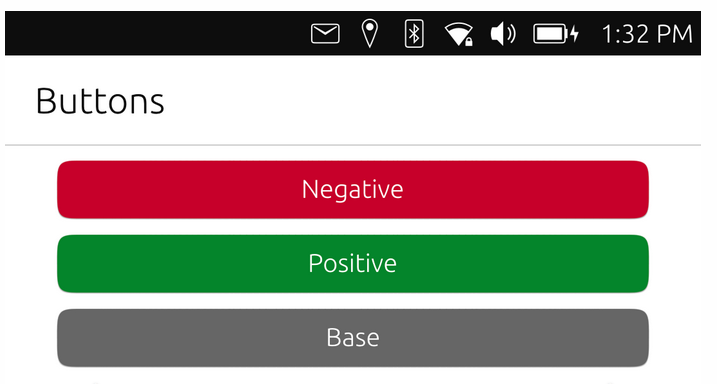
Nearly all of the default applications that ship with Ubuntu Touch went through this treatment, allowing for consistency across the application ecosystem. In addition, some small UI effects were added in order to make buttons and other widgets “pop” more against their background.
Another major area of improvement includes one of the most important features in any mobile operating system — the (virtual) keyboard. In this release, the Ubuntu Touch keyboard has gained functionality including the ability of a bottom-swipe gesture to switch from the normal keyboard to the editing overlay. Consequently, all layouts can now access the editing overlay, which was not possible previously. Moreover, double-tapping in the blank area of the editing overlay will now switch between the two modes — selection and cursor mode — and the “Done” button exits appropriately from either mode.
Additionally, the default web browser that ships with Ubuntu Touch, the Morph Browser, saw some improvements with the latest release including private browsing deleting only the current session instead of all sessions upon leaving, a cookie deletion button, functionality for an application built with the webapp container to download files, more fluid dropdown options along with crash fixes for them, and an automatic fit-to-width feature, which allows the browser to attempt to zoom a webpage automatically when enabled.
This is a massive release from the UBports community and is a huge stepping stone to becoming a viable mobile operating system alternative in our iOS and Android-dominated world. I want to give my sincere congratulations to UBports and anyone else who helped make this release possible. Keep up the incredible work and I can’t wait to see what the future holds for the Linux-based mobile operating system world!
There are a ton of other miscellaneous changes, fixes, and updates that come along with OTA-12 that couldn’t be covered here, however, if you would like to read more, you can find UBports’ official release notes here. In addition, if you would like to try out the newest Ubuntu Touch, you can find the most recent images here.
Hefftor Linux Project Unveiled

There is no doubt that the Arch Linux ecosystem is growing at an extremely rapid pace today, mostly in an attempt to bring the power and freedom of Arch Linux to an increasingly broader audience of users. This is no longer the Arch of the past where only superusers had the knowledge and skill to leverage the unmatched power, flexibility, and configurability of the nearly twenty-year-old distribution. With distributions like Manjaro, EndeavourOS, and ArcoLinux in the mix, Arch has transformed to become — dare I say? — user friendly.
Of the aforementioned user-friendly Arch Linux implementations, ArcoLinux is actually designed as a sort of training ground for those wanting to explore and improve their skills with Arch Linux before plunging into the deep end. In fact, when you visit the ArcoLinux official website, the largest text on the page is “LEARNING PATH”, which entails a set of steps or guidelines that a user can follow to move from very user-friendly versions of ArcoLinux into more pure Arch-like implementations. Each step provides less “hand-holding” and more flexibility, configurability, and even the ability to create your own ArcoLinux ISO!

This week, a new project was unveiled that uses ArcoLinux as it’s base system — Hefftor Linux. The new distribution is described as an “ArcoLinux spinoff designed for style and stability”, and it certainly appears to live up to the tagline. The idea behind Hefftor is to provide ArcoLinux users (and potential users) with a polished, well-maintained, and stable ArcoLinux implementation out-of-the-box including professional theming for a wide variety of desktop environments and window managers.
Hefftor Linux is the brainchild of Brad Heffernan, one of the ArcoLinux core developers who has built quite a few of the popular ArcoLinux tools available today. Since ArcoLinux tries to maintain as close of a relationship to pure Arch as possible, the default implementation is pretty vanilla. However, Brad’s Hefftor Linux plans to spice that up a bit by providing professional polish and design to make ArcoLinux pop out-of-the-box, no matter which desktop environment or window manager you use!
Though the project is still young, it currently supports several desktop implementations including the flagship Xfce, KDE Plasma, Bspwm, i3wm, and Herbstluftwm. Though the Xfce implementation is their flagship, the team behind Hefftor Linux is focused on providing a better experience for window mangers so that new users can discover them, using the popular Bspwm as their most focused implementation.

In addition to the Hefftor Linux project, there is an on-going joint project between Brad and Red Rayner of the LionOS project, aptly named HefftyLionOS. This project particularly focuses on the GNOME and MATE desktop environments and their integration with ArcoLinux. At the time of this writing, it appears that the GNOME edition is the most popular out of all Hefftor and HefftyLionOS versions available.
This is definitely an interesting project and one that I will continue to keep a close eye on. If you would like to check out the Hefftor Linux project, you can find their extremely awesome official website here. You can also follow the project on YouTube, LBRY, Telegram, and Facebook. In addition, you can find all of the downloads available on the homepage.
Microsoft: On the Wrong Side of History

This week brought another massive headline announcement that many in the Linux and greater open source community have been waiting decades to hear — Microsoft is admitting that it was wrong about open source software all along and is ashamed to be on the “wrong side of history”. The admission from Microsoft President, Brad Smith, took place at a private, online event hosted by the esteemed Massachusetts Institute of Technology (MIT) billed as “A Conversation with Microsoft President Brad Smith”. This announcement from Brad comes only a week prior to their major developer conference — Microsoft Build.
From Brad Smith’s MIT talk:
“Microsoft was on the wrong side of history when open source exploded at the beginning of the century, and I can say that about me personally. The good news is that, if life is long enough, you can learn that you need to change.”
Of course, Brad is referring to the infamous statement by former Microsoft CEO Steve Ballmer when he said that Linux “is a cancer that attaches itself in an intellectual property sense to everything it touches […] Government funding should be for work that is available to everybody, but open source is not available to commercial companies” back in 2001. In fact, Brad (who has spent 25 years at Microsoft) previously worked on the company’s vicious legal team during its battles with open source software. He knows, better than most, the tragic position that Microsoft held against the open source world and under his leadership, the company appears to have taken a drastic U-turn from their Ballmer era demons. This is not your daddy’s Microsoft (or so they say).

Though the tech giant may appear to many in the outside world to have gained world domination over the technology arena, especially in that of operating systems, they actually only “dominate” a single, relatively small space— the personal computer. The server, development, web, mobile, scientific, and cloud computing arenas (and everything in between) are completely overrun by Linux and other UNIX-based operating systems like FreeBSD, macOS, iOS, and Android (which itself is Linux-based).
Linux and open source software is so pervasive in our world today, from the smallest single-board devices to running the world’s largest supercomputers, our society as we know it would completly shut down from its disappearance. In this respect, it is obvious that Microsoft has long lost the battle against Linux and open source. Even the company’s most lucrative project, Microsoft Azure, has been forced to adopt Linux in order to compete with other major cloud service providers like Amazon Web Services (AWS) and the Google Cloud Platform (GCP).

This somewhat apologetic statement from the top comes at a time when Microsoft has grown to become a key contributor to a multitude of open source projects, have acquired both GitHub and npm Inc., and are ramping up work on their Windows Subsystem for Linux (WSL), a project that attempts to make utilizing Linux inside of Windows 10 easy and even integral through a compatibility layer. I will skip over the details of these projects and events as I recently covered them in the Linux++ from March 29, 2020 where you can find my thoughts and opinions on them here. In fact, it is noted that Microsoft has risen to become the single largest organization to contribute to open source projects all over the world. Who would have ever guessed? (I think many people imagined hell would freeze over first)
Though it is nice to receive public affirmation from the very top of an (old?) arch enemy as large as Microsoft, many in the Linux community will only be persuaded by actions — we’ve heard similar songs sung before. After all, they basically invented the EEE marketing strategy, embrace, extend, extinguish. Some wishes from the open source community include better transparency from the company, including the removal mandatory telemetry and update methods in Windows 10 and the open sourcing of some of their more important software.

For many, it is only through actions like these that the olive branch will be accepted. After all, they’re surrounded, and it has become increasingly clear that there is simply no place for a company like the old Microsoft in today’s rapidly evolving technology world.
It is likely that more details related to Microsoft’s involvement in the open source ecosystem will be revealed and paraded throughout the Microsoft Build event next week, so it will be interesting to see if they will ever actually “walk the walk”.
Community Voice: Joshua Peisach

This week Linux++ is very excited to welcome Joshua Peisach (aka ItzSwirlz), founder and lead developer of the Ubuntu Cinnamon Remix project. In early December of last year, a new project was announced. It combined two of my personally favorite things — an Ubuntu base with the Cinnamon desktop environment. Since that time, the project has blown up and the developer behind it, Joshua, has come a long way in his Linux journey. Joshua is an extremely welcoming, helpful, and passionate member of the Ubuntu community at a very early age. So, without further ado, I’m happy to present my interview with Joshua:
How would you describe Linux to someone who is unfamiliar with it, but interested?
“This is pretty interesting since Linux to me comes in different shapes and forms. To someone who is unfamiliar with it, but interested, I would say that if you want to try a brand new (to them), free operating system that is compatible through many devices, open source, and has plenty of customization to your limits as a traditional, modern, or elegant desktop, Linux is truly the way to go. I mainly describe it as ‘a more customizable, faster, smoother, and better option than other operating systems such as Windows or macOS.’”
What got you hooked on the Linux operating system and why do you continue to use it?
“The first time I ever touched Linux was around 2014 and if it was close to anything, it was CentOS (can’t remember exactly what version). My dad works at a university with some crazy technological-molecule related stuff and they use Linux. So, when I was very young, I played around with VirtualBox. Through that, I found Ubuntu and version 14.04 was the first install of Ubuntu I ever did. The main reason I’m hooked on it now and it has more appeal to me than back when I still used Windows 7, is that now I have a better laptop (Dell Inspiron 15–3567) that has enough disk space for me to dual-boot Linux.

So, I did, and found out how much faster, more comfortable, and fun it was (although, I still see that Window was great and should always still be by your side as a good pal). I continue to use Linux as it is amazing and purely open, where you can develop the software and make whatever you want and nobody will have anything to say about it because you can make it available from everywhere pretty much.”
What do you like to use Linux for? (Gaming, Development, Casual Use, Tinkering/Testing, etc.)
“I primarily use Linux for…everything really! I game and I develop, which is why I picked Fedora as my first dual-boot OS, because I wanted a development OS and a gaming OS (Windows). I pretty much use it for almost everything as it is a great sandbox where you can easily revert things if you need to with the tools we have. So, it’s my everyday use OS and just like other Windows applications, if I can’t run it, I load it up on Windows. So mainly, you’ll see me on Linux. For everything.”
Do you prefer a specific distribution or family of distributions and why? Do you prefer a particular desktop environment(s) or tiling window manager for your workflow and why?
“When I knew I was moving to Linux, I wanted a distribution I’d like, but then I realized what differentiates a distro from a desktop environment — GNOME, LXQt, LXDE, Xfce, Cinnamon, Deepin — it never ends. I don’t use a fancy window manager — as long as it’s something I can work with. I needed to pick a desktop, and as I said, I came back to Ubuntu and I didn’t know that Unity was gone when I returned in 2018, just after 18.10 was released. I installed Unity to see what it was and I sort of cried as it brought back so many memories. It makes so much more sense in context to when I first installed it five years previously.

I ended up with Ubuntu’s spin of GNOME, where it’s elegant, customizable, and very tweaky, where I can fulfill all of my taste. But if not, I typically would use any other mainline desktop that is elegant or has great customization with third-party extensions like Plasma, Deepin Desktop Environment, and Cinnamon. And for distributions…it’s complicated. Let’s say Debian, Fedora, or openSUSE-based and leave it at that.”
What is your absolute favorite aspect about being part of the Linux and open source community?
“My absolute favorite aspect of being part of the greater Linux community is how easy it is to communicate with people and find people similar to you, especially when you need them. I was surprised to find many people like me and I understood the history of Ubuntu better. As a developer, I find it pretty interesting how the world is open — ask away and someone will always be there to help you or be with you at any given time. It sure is a great way to talk to people that are like you and that you know are safe to talk to and won’t harm you in any way.”
What is one FOSS project that you would like to bring to the attention of the community?
“There is so much with comparing distros and their other services, I don’t really have one. I’d rather see any Debian or Ubuntu spins to be exact. I think they’re cool and have a track record (most of the Linux distros I played/play with are Ubuntu-based) of growing and thriving, as they have a purely wonderful ground to build on.”
Do you think that the Linux ecosystem is too fragmented? Is fragmentation a good or bad thing in your view?
“I think the Linux ecosystem is a little fragmented and I’m saying this in a more negative, but also neutral, way. It causes a bunch of comparisons, arguments that lead to messes, and lots of confusion to new people or regular users. So, stick with a community like EndeavourOS or Ubuntu that respects everyone and everything and you should be okay.”
What do you think the future of Linux holds?
“Short-term, I think Linux will continue to thrive and be truly amazing. However, in the long-term, Linux may come to a point where extra distros keep piling up and there are so many desktop environments. It might become pointless and we will all need to stick to one. Things like this could cause other questions when compared to Windows.”
How did your adventure into developing for Linux come about?
“My adventure into developing for Linux came about when I stepped up to create an Ubuntu Cinnamon Remix. From there, I learned Debian packaging and spread my knowledge base into deeper code. I have had experience with programming languages in the past, so it is going well.”
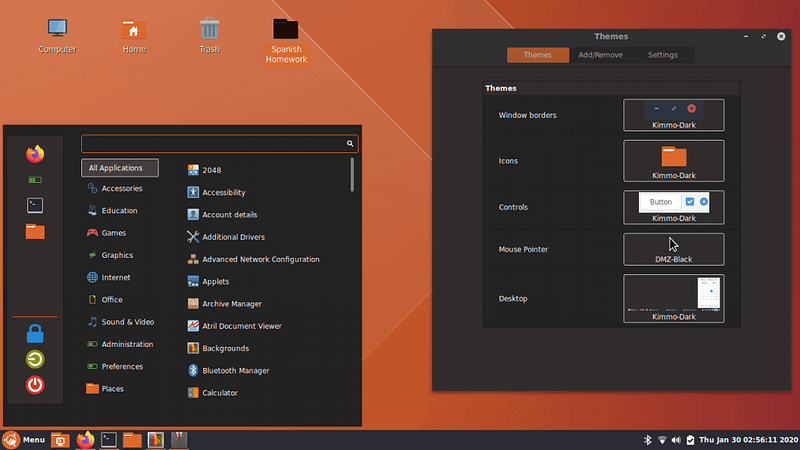
What has your experience as a younger member of the Linux developer community been like? Have there been any obstacles or are people generally enthusiastic about having younger people join the Linux development world?
“Pretty much everyone is enthusiastic about younger people in the Linux world. My experience has been pretty good and it has allowed me to progress with learning the skills I need quite a lot. There have barely been any obstacles besides toxic people in general.”
Where did the idea of creating a Cinnamon flavor of Ubuntu come from? For those who don’t know, can you explain some differences between your project and the creator of the Cinnamon desktop, the Linux Mint project?
“The idea behind creating a Cinnamon flavor of Ubuntu is frankly complicated. I knew about Cinnamon/Linux Mint’s flagship DE when I tested it in a VM and loved it. I saw there was no Cinnamon flavor when I was studying DEs and I suggested it. I was basically greeted with ‘nobody has stepped up to do it’ (yes, there were other Cinnamon Remixes out there) and then I knew it would be great for those wanting a Windows 7-like desktop.
There are MANY differences between Ubuntu Cinnamon Remix and the Linux Mint Cinnamon Edition project. Linux Mint builds from Ubuntu, which builds from Debian Unstable. However, the Ubuntu they build from is only LTS releases, which basically means their packages get updated every two years when an LTS is released. So, you won’t always get the latest packages in Linux Mint where Ubuntu Cinnamon Remix will.
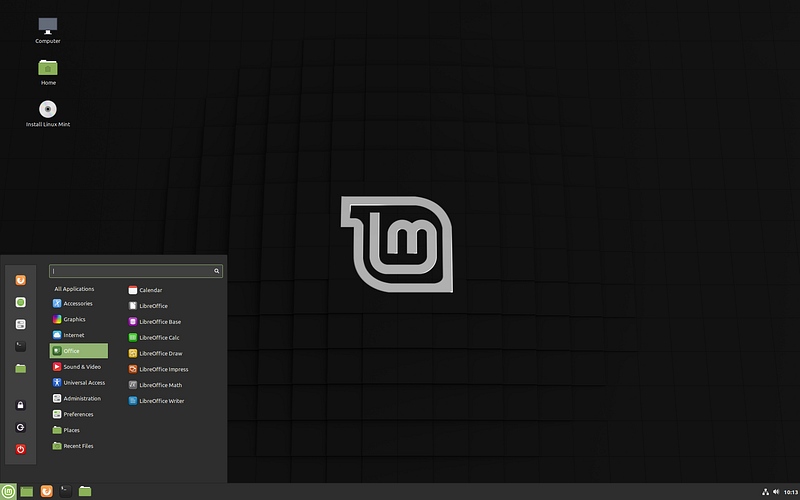
In Linux Mint, they develop a bunch of extra software such as their own Firewall, USB Stick Tool, and more. However, Ubuntu Cinnamon Remix solely relies on existing software, mainly GNOME and MATE software as they typically work well with Cinnamon and are all related to each other through the GTK Toolkit after the GNOME ‘breakup’ in 2011 (when GNOME switched to the more elegant style it currently uses, so people made derivatives to preserve a more traditional desktop style).
Basically, Linux Mint is their own project with their own desktop based off pure Linux system utilities like systemd and Ubuntu Cinnamon Remix just brings the Cinnamon desktop environment to Ubuntu.”
Since Ubuntu Cinnamon Remix is a relatively new project, what has your experience been like with trying to build a vibrant community around the distribution? Has visibility of the project come organically or have you had to promote it a bit in order to build the community and gain some momentum?
“The experience of building a community and getting this whole thing together actually requires quite a bit of promoting and explaining. People don’t get how open source works. I believe the reason that the Ubuntu DDE Remix exploded faster was not because they used an elegant desktop. For some reason, people think that we are trying to ‘compete against’ Mint or ‘take down Mint’ or ‘overrule Mint’. Heck, I even checked the Linux Mint forums and some thought that we were planning to merge. It’s been hard, but I rely on Ubuntu community friends and then use that to get something good out there to promote it themselves via news articles and the like.”
Are there any Ubuntu Cinnamon Remix-specific features that you think sets it apart from other distributions? Is there a particular “target audience” that Ubuntu Cinnamon Remix is trying to reach?
“There aren’t really any specific features besides our Layout-switching tool, folder color switcher, and more to come. Our goal is basically to expand the Cinnamon DE to it’s fullest. Some people complain about Mint and some just want a Windows 7-like feel to their Linux desktop. So, those two are basically the only target audiences besides those who like to try new distros and DEs out.”
It is often said that the different Ubuntu flavors help each other out quite significantly. Can you talk a little bit about what your experience has been regarding working with other Ubuntu flavors’ developers?
“Actually, Ubuntu Cinnamon Remix wouldn’t have come this far if it weren’t for the following people:
- David Mohammed (fossfreedom, Ubuntu Budgie Lead)
- Erich Eickmeyer (Eickmeyer, Ubuntu Studio Lead/Council Chair)
- Simon Quigley (tsimonq2, Lubuntu Lead)
- Rik Mills (rikmills, Kubuntu Lead, Ubuntu MOTU)
- Dan Simmons (kc2bez, Lubuntu Developer, I think artwork)
- Carlos Echenique (from BDLL for creating the Telegram group and allowing us to promote it on BDLL from there)
- Anyone from BDLL (speaking of it)
- Alan Pope (popey, Snapcraft Lead)
- Martin Wimpress (mwimpress, wimpy, flexiondotorg, Ubuntu MATE Lead and Ubuntu Desktop Team Lead)
- Chanath (Desilvachanath, Ubuntu Community Member)
- Debian Developers and the Cinnamon Team
- Everyone who contributes to Ubuntu and literally everyone else who makes or contributes to the Cinnamon desktop environment
As I said earlier, everyone will be there for you. Fossfreedom really gave me the kick into life that I needed to get this project off the ground along with Ubuntu DDE Remix (and yes, I plan to work with their developer, Arun). Literally everyone will help if you need it and let’s be fair — I feel like I did have a little bit of slack in the beginning. I look back and see that I was a bit greedy for fame and immature about it, but then I learned that I had really great foundations with the Debian-Cinnamon team and Ubuntu base. Literally, these guys are legends. They are even helping Kai Lyons of Ubuntu Lumina Remix get on their feet. I built her an ISO a few days ago.
Working with the Ubuntu Flavor Developers is something that is a true gift — I can’t express that enough. Thank you SO MUCH to all those who have helped me get this far, and I really don’t say that enough. The words — ‘to all those who have helped me get this far’ — really can go a long, long, LONG way.”
What is your absolute favorite part of working on a project like Ubuntu Cinnamon Remix?
“My absolute favorite part of working on Ubuntu Cinnamon Remix is first, to be fair, getting to hang out and do stuff with such a cool and amazing project with loads of amazing people. Second, you can have so much fun, you learn so much and it can really help you mentally and socially. And the third and final thing is, there is always more to be done. In between releases, we have a half of a year to put in whatever we can. And with the help of everyone else, we can truly make it amazing.”
Is there anything exciting planned for the future of Ubuntu Cinnamon Remix, without giving too much away?
“Keep your eyes peeled for the best way you can extend the Cinnamon DE to the fullest. :P”
Do you have any major personal goals that you would love to achieve in the near future?
“I plan on getting into a really good university where I can thrive and get a good job in computer programming or Linux development. I may even end up as a Canonical worker/helper or something. It truly helps, every cent or bit. Otherwise, I plan to just enjoy life and have the freedom to do what I want or desire.”

I just want to wholeheartedly say thank you to Joshua for taking time out of his extremely busy schedule to prepare an interview with Linux++. Being a younger member of the Linux community and a distro-maintainer undoubtedly has its own challenges, however, Joshua has risen to become a major personality in the Ubuntu community through his determination. I know that Joshua has an extremely bright future ahead and I’m sure that he will be a role model for the younger generation in adopting desktop Linux as a development and everyday use platform. Keep up the incredible work on Ubuntu Cinnamon Remix and I wish you nothing but the best with your future endeavors!
If you would like to follow along with the latest news from Joshua and the Ubuntu Cinnamon Remix, you can follow the project on Twitter, Telegram, or check out the official website here.
Linux Desktop Setup of the Week
This week’s selection was presented by u/thunderthief5 in the post titled [GNOME] Red. Here is the screenshot that they posted:
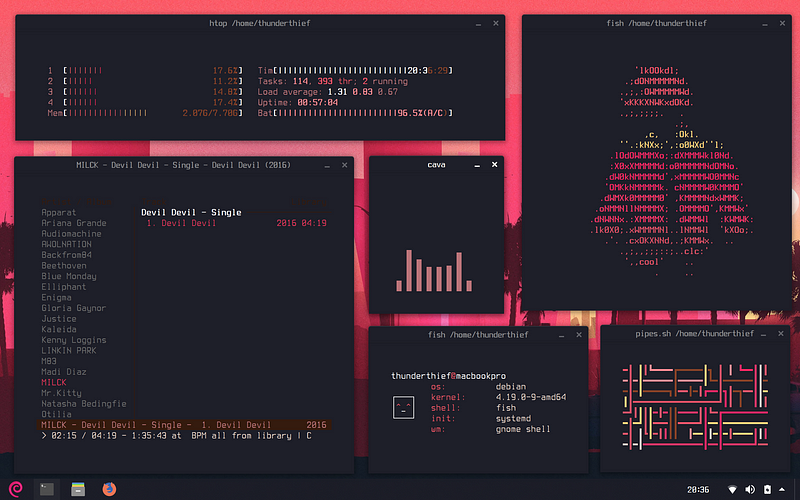
And here are the system details:
OS: Debian 10
DE: GNOME 3
WM: Mutter
Theme: Ant
Terminal: gnome-terminal
Wallpaper: City Buildings Night
Thanks, u/thunderthief5, for an awesome, unique, and well-themed GNOME desktop!
If you would like to browse, discover, and comment on some interesting, unique, and just plain awesome Linux desktop customization, check out r/unixporn on Reddit!
See You Next Week!

I hope you enjoyed reading about the on-goings of the Linux community this week. Feel free to start up a lengthy discussion, give me some feedback on what you like about Linux++ and what doesn’t work so well, or just say hello in the comments below.
In addition, you can follow the Linux++ account on Twitter at @linux_plus_plus, join us on Telegram here, or send email to linuxplusplus@protonmail.com if you have any news or feedback that you would like to share with me.
Thanks so much for reading, have a wonderful week, and long live GNU/Linux!

Wow. A 10 year old is involved in making the Ubuntu Unity Remix. Respect and great news. I really have to try it out. Although I am not sure anymore about Nautilus as the file manager. It lost so many features. I would probably use something else like UMix does.
As for Ubuntu Cinnamon Remix, I have a mixed feeling because you actually get most updates for the desktop (Cinnamon) through all the point releases of the lifetime of a Mint release whereas in Ubuntu LTS you do not or you rely on PPAs. Of course Joshua is right, on the interim releases you get all the newest packages and probably the newest features of the Cinnamon desktop.
Join the discussion at forum.tuxdigital.com